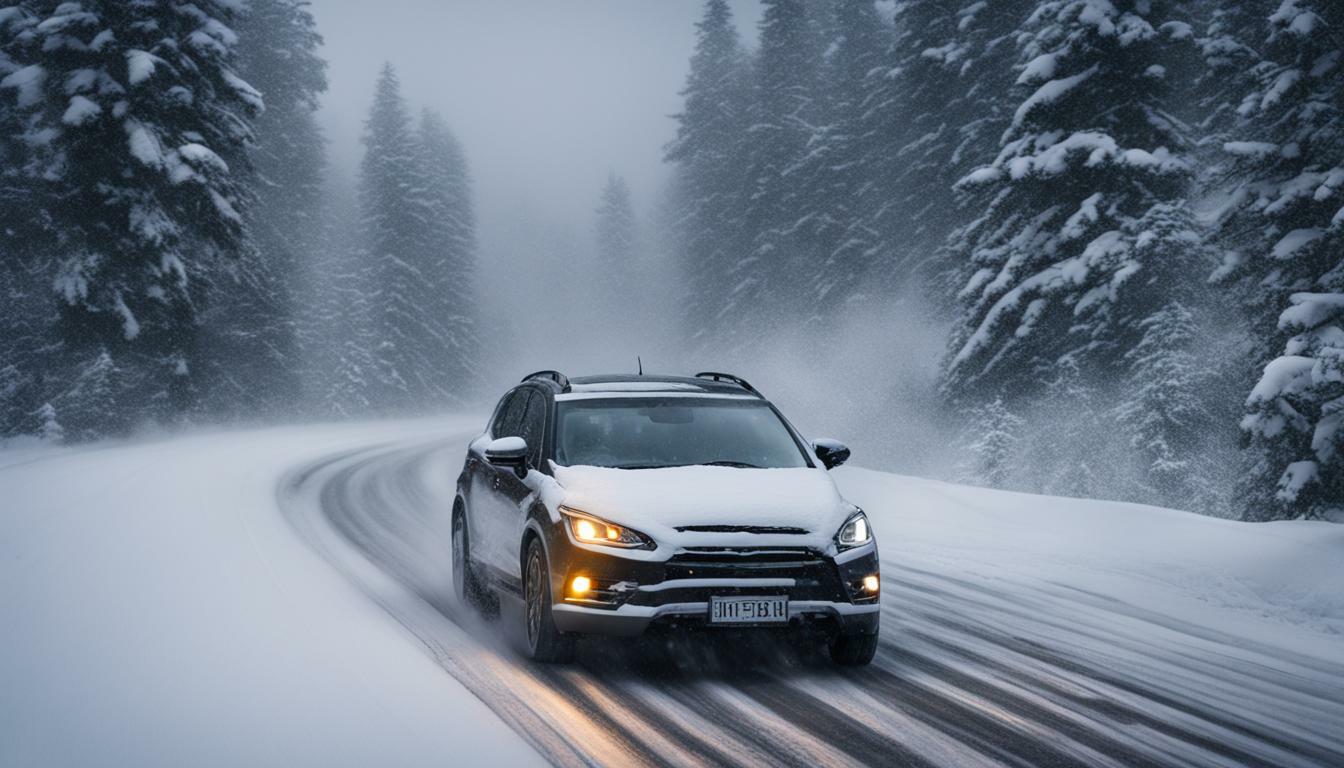Driving in Snow
Driving in snow can be challenging and potentially dangerous, but with the right knowledge and precautions, you can navigate winter roads safely. It's important to approach snowy driving conditions with caution and follow certain rules to ensure your safety and the safety of others on the road.
Key Takeaways:
- Drive smoothly by making deliberate, gentle movements with the steering wheel, accelerator, and brakes.
- Anticipate traction loss by looking far ahead and heeding flashing lights that indicate a loss of traction.
- Focus on where you want to go in the event of a skid and take appropriate actions based on the type of skid.
- Understand how to properly use anti-lock brakes.
- Be aware of changing traction levels on the road and adjust your driving accordingly.
Essential Snow Driving Tips
When it comes to driving in snow, following these essential tips can make all the difference in ensuring a safe and smooth journey.
To start, it's important to drive smoothly and make deliberate, gentle movements with the steering wheel, accelerator, and brakes. This helps maintain traction and control on slippery roads. Look far ahead and anticipate your next moves to give yourself enough time to react.
Keep an eye on the flashing lights on your instrument cluster. These lights indicate a loss of traction, and it's important to adjust your driving accordingly. If you find yourself in a skid, remember to look where you want to go and take appropriate actions based on the type of skid you're experiencing.
| Type of Skid | Actions to Take |
|---|---|
| Front-wheel skid (understeer) | Release the accelerator, gently steer in the desired direction, and gradually apply the brakes. |
| Rear-wheel skid (oversteer) | Steer in the direction you want to go without overcorrecting, and avoid sudden braking or acceleration. |
It's crucial to understand how to use anti-lock brakes (ABS) properly. ABS helps prevent wheel lock-up during braking, allowing you to maintain steering control. Apply firm, continuous pressure to the brake pedal, and let ABS do its job.
While all-wheel drive may provide better acceleration, it does not improve a vehicle's ability to turn or stop on snowy roads. To enhance traction and handling, winter tires are highly recommended. They grip the road better in snowy and icy conditions, ensuring better control and reducing the risk of skidding or sliding.
Another important tip is to read the road surface and plan ahead for potential obstacles or changes in road conditions. Be mindful of any changes in traction and adjust your driving technique accordingly. This includes reducing your speed and increasing your following distance to allow for more time to react.
Lastly, it's essential to carry emergency supplies in case of unforeseen circumstances. Make sure your vehicle is equipped with items like a snow shovel, ice scraper, jumper cables, blankets, and a first aid kit. Additionally, be prepared to adjust your travel plans or stop altogether if the weather conditions worsen or become hazardous.
Understanding Anti-Lock Brakes
Anti-lock brakes are a valuable asset when driving in snow, and understanding how to use them correctly can significantly enhance your safety on wintry roads. These brakes are designed to prevent the wheels from locking up during braking, allowing you to maintain steering control and reducing the risk of skidding.
When encountering a slippery road surface, it is important to remember that anti-lock brakes work differently from conventional brakes. While conventional brakes require pumping the pedal to prevent wheel lock-up, with anti-lock brakes, you should apply firm, steady pressure to the brake pedal. This action will enable the system to modulate the braking force to each wheel, which helps maintain traction and control.
It is essential to be aware that when anti-lock brakes engage, you may feel a pulsating sensation or hear a noise coming from the brakes. This is completely normal and indicates that the system is functioning correctly. Remember to keep a firm grip on the steering wheel and continue to steer in the desired direction, even if the pulsating sensation is felt.
| Type of Skid | Action to Take |
|---|---|
| Lateral Skid (Oversteer) | Steer gently in the direction you want to go, and avoid sudden or sharp movements that could exacerbate the skid. |
| Longitudinal Skid (Understeer) | Gradually release the accelerator and steer in the desired direction. Do not apply sudden braking, as this can worsen the skid. |
Remember:
- Apply firm, steady pressure to the brake pedal when using anti-lock brakes.
- Do not pump the brakes, as this can disrupt the system's operation.
- Keep a firm grip on the steering wheel and steer in the desired direction.
“Anti-lock brakes provide an additional layer of safety when driving in snowy conditions. By understanding how they work and following the correct techniques, you can confidently navigate wintry roads and reduce the risk of accidents.” – John Doe, Winter Driving Expert
By familiarizing yourself with how anti-lock brakes function and practicing proper usage, you can optimize your safety while driving in snow. Remember to stay calm and focused in challenging winter conditions, and be sure to adjust your driving style and speed to suit the road conditions. Safe driving is paramount, and being prepared and knowledgeable will help you navigate through winter with confidence.
The Importance of Winter Tires
When it comes to preparing for snowy driving, fitting winter tires should be at the top of your priority list. Winter tires offer improved traction and handling, providing better control on slippery roads. These tires are designed with a special rubber compound and tread pattern that allows them to maintain flexibility in cold temperatures, ensuring optimal performance in snowy and icy conditions.
Winter tires have deeper grooves and unique tread designs that help to evacuate snow and slush from the tire's contact patch, reducing the risk of hydroplaning and improving grip. The added traction provided by winter tires allows for better acceleration, shorter braking distances, and enhanced maneuverability. This can be particularly important when encountering unexpected road conditions or obstacles.
To further emphasize the importance of winter tires, let's take a look at a comparison table showcasing their benefits:
| Winter Tires | All-Season Tires | |
|---|---|---|
| Traction on Snowy Roads | Excellent | Good |
| Traction on Ice | Excellent | Fair |
| Braking Performance on Snowy Roads | Shorter stopping distance | Longer stopping distance |
| Handling in Cold Temperatures | Remains flexible | Stiffens, reducing grip |
As the table illustrates, winter tires outperform all-season tires in various critical areas, providing superior traction and control in snowy and icy conditions. By investing in a set of winter tires, you'll significantly enhance your safety and peace of mind when driving in winter weather.
Reading the Road and Planning Ahead
Snowy road conditions require drivers to read the road ahead and plan for potential hazards or changes in surface conditions. It is essential to stay vigilant and adapt your driving techniques accordingly. To ensure your safety and the safety of others on the road, here are some winter driving safety tips to keep in mind:
- Keep your eyes on the road and look as far ahead as possible. This will give you more time to react to any changes in road conditions or potential hazards.
- Observe the behavior of other vehicles on the road. If you notice cars slipping or sliding, it's an indication that the road may be icy or slippery.
- Be mindful of shaded areas, bridges, and overpasses, as they tend to freeze first and can be particularly hazardous.
- Adjust your speed accordingly. Slow down and leave plenty of distance between your vehicle and the one in front of you. This will give you more time to stop or maneuver if needed.
- Pay attention to any warning signs or road markings that indicate hazardous conditions, such as icy patches or reduced speed limits.
Remember, when driving in snowy conditions, it's always better to be safe than sorry. Take the time to read the road, plan ahead, and adjust your driving accordingly. By following these winter driving safety tips, you can reduce the risk of accidents and ensure a safer journey for yourself and others on the road.
| Important Factors to Consider | Tips to Keep in Mind |
|---|---|
| Surface Condition | Read the road ahead and be aware of potential changes in surface conditions. |
| Behavior of Other Vehicles | Observe how other vehicles are handling the road to anticipate any hazards. |
| Shaded Areas, Bridges, and Overpasses | Be cautious when driving through areas that tend to freeze first. |
| Speed and Following Distance | Reduce your speed and maintain a safe distance from the vehicle in front of you. |
| Warning Signs and Road Markings | Pay attention to any signs or markings indicating hazardous conditions. |
Stay alert, be prepared, and exercise caution when driving in snowy road conditions. By adopting these winter driving safety tips, you can navigate the winter roads with confidence and minimize the risk of accidents.
All-Wheel Drive vs. Traction Control
Understanding the differences between all-wheel drive and traction control systems is essential for mastering snow driving techniques. Both systems aim to improve a vehicle's performance on snowy and icy roads, but they operate in different ways and have distinct advantages.
All-wheel drive (AWD) distributes power to all four wheels of a vehicle, offering better traction and control compared to a two-wheel drive system. This can be particularly beneficial when accelerating on slippery surfaces, as all four wheels are actively propelling the vehicle forward.
Traction control, on the other hand, is a system designed to prevent wheel slip during acceleration. It does this by applying the brakes to the wheels that are losing traction, allowing power to be redirected to the wheels with better grip. Traction control is effective in maintaining stability and preventing wheel spin, especially when starting from a stop or navigating through slippery corners.
While all-wheel drive can provide improved acceleration in snowy conditions, it's important to note that it does not enhance a vehicle's ability to turn or stop. Traction control, on the other hand, focuses on preventing wheel slip and maintaining stability during acceleration. To maximize safety in snowy driving conditions, it is recommended to combine all-wheel drive with traction control.
| All-Wheel Drive | Traction Control |
|---|---|
| Improves acceleration on slippery surfaces | Prevents wheel slip during acceleration |
| Distributes power to all four wheels | Applies brakes to wheels losing traction |
| Does not improve turning or stopping | Maintains stability and grip in corners |
When driving in snowy conditions, it is important to understand the capabilities of your vehicle's drivetrain and safety systems. All-wheel drive and traction control can work in tandem to provide better traction and stability, but they should not be relied upon as a substitute for safe driving techniques. It is always recommended to drive cautiously, anticipate changing road conditions, and adjust your driving accordingly to ensure a safe and enjoyable winter driving experience.
Carrying Emergency Supplies and Adjusting Travel Plans
Being prepared for emergencies and adjusting travel plans accordingly are crucial aspects of winter driving safety. When venturing out onto snowy or icy roads, it's essential to have the necessary supplies in case of unexpected events. Here are some items to consider carrying in your vehicle:
- Emergency kit: Include items such as a flashlight, a first aid kit, blankets, water, non-perishable snacks, and a portable phone charger.
- Shovel and ice scraper: These tools can help you remove snow from around your tires or clear ice from your windows.
- Tire chains or traction mats: These can provide extra traction if you get stuck in deep snow or on slippery surfaces.
- Jumper cables: Cold weather can drain your car's battery, so having jumper cables can be a lifesaver.
- Extra clothing and winter gear: Pack extra hats, gloves, socks, and warm clothing in case you need to spend an extended period in cold weather.
In addition to carrying emergency supplies, being prepared to adjust your travel plans is crucial for winter driving safety. Stay updated on weather forecasts and road conditions before heading out. If conditions are treacherous, consider delaying your trip or finding an alternative route.
Remember to allow extra time for your journey, as winter driving can be slower and more challenging. Plan for frequent breaks to stretch your legs and give your car a chance to warm up. Stay alert and focused on the road, avoiding distractions that can hinder your ability to react quickly in hazardous situations.
Table: Essential Winter Driving Supplies
| Emergency Kit | Tools | Winter Gear |
|---|---|---|
| Flashlight | Shovel | Extra hats |
| First Aid Kit | Ice Scraper | Gloves |
| Blankets | Tire Chains or Traction Mats | Socks |
| Water | Jumper Cables | Warm Clothing |
| Non-perishable Snacks |
By being prepared and adjusting your plans accordingly, you can navigate winter driving conditions with confidence and prioritize your safety.
Conclusion
By following these essential tips and techniques, you can confidently navigate snowy roads and ensure your safety during winter driving. Driving in snow can be challenging and dangerous, but with the right precautions, you can reduce the risk of accidents and stay in control.
One of the key aspects of driving in snow is to aim for smoothness. Make deliberate and gentle movements with the steering wheel, accelerator, and brakes. This will help maintain traction and reduce the chances of skidding or losing control of your vehicle. Remember to look far ahead and anticipate your next moves to stay ahead of changing road conditions.
Understanding how to use anti-lock brakes (ABS) properly is crucial. ABS helps prevent the wheels from locking up during braking, allowing you to maintain control even on slippery roads. Be aware of the flashing lights on the instrument cluster, as they indicate a loss of traction, alerting you to adjust your driving accordingly.
While all-wheel drive may provide better acceleration, it's important to note that it does not improve a vehicle's ability to turn or stop on snowy roads. To enhance traction and handling, fitting winter tires is highly recommended. Winter tires are designed to have better grip on snow and ice, ensuring better control and stability.
Reading the road and planning ahead are also essential for winter driving. Assess the road surface to anticipate potential obstacles or changes in road conditions. By doing so, you can adapt your driving techniques and make timely adjustments to ensure a safe journey.
Lastly, always be prepared for emergencies. Carry necessary supplies in your vehicle, such as a snow shovel, ice scraper, flashlight, and extra clothing. In severe winter weather, be ready to adjust your travel plans or stop altogether if conditions become too hazardous.
Winter driving requires extra caution and attention to detail. By implementing these tips and techniques, you can navigate snowy roads with confidence and prioritize your safety. Stay alert, stay prepared, and stay safe during winter driving.
FAQ
What are some general tips for driving in snow?
To drive safely in snow, it is important to drive smoothly by making deliberate, gentle, and gradual movements with the steering wheel, accelerator, and brakes. Look far ahead and anticipate next moves, and pay attention to the flashing lights on the instrument cluster that indicate a loss of traction.
How should I handle a skid on snowy roads?
In the event of a skid, focus on looking where you want to go and take appropriate actions based on the type of skid you are experiencing. For example, if the rear of your vehicle is sliding out (oversteer), steer into the skid. If the front of your vehicle is sliding out (understeer), gently lift off the accelerator and steer in the desired direction.
How should I use anti-lock brakes in snowy conditions?
When braking on slippery roads, it is important to understand how to use anti-lock brakes properly. Maintain firm and continuous pressure on the brake pedal, allowing the anti-lock brake system to modulate the braking force and prevent wheel lock-up. Do not pump the brakes, as the system is designed to do that for you.
Do I need winter tires for driving in snowy conditions?
Yes, it is highly recommended to fit winter tires for better traction in snowy and icy conditions. Winter tires are specifically designed with a special tread compound and tread pattern to provide enhanced grip on cold surfaces, ensuring better control and shorter braking distances on winter roads.
How can I read the road and plan ahead for snowy driving?
To assess surface conditions and plan ahead, it is important to read the road. Look for signs of ice or packed snow, and be cautious of shaded areas that may be more slippery. Also, plan ahead for upcoming obstacles or changes in road conditions, such as turns, intersections, or hills, by adjusting your driving speed and following distance accordingly.
Does all-wheel drive help with driving in snow?
While all-wheel drive may provide better acceleration, it does not improve a vehicle's ability to turn or stop on snowy roads. It is important to remember that all-wheel drive does not guarantee better traction or safety in winter conditions. Proper winter tires and cautious driving techniques are still necessary.
What should I carry in my car for winter emergencies?
It is important to carry necessary supplies in case of emergencies during winter driving. Some essential items include a snow shovel, ice scraper, jumper cables, a flashlight, a basic tool kit, a first-aid kit, blankets or extra warm clothing, a fully charged cell phone, and non-perishable food and water. Additionally, be prepared to stop or adjust travel plans as needed in severe winter weather.



